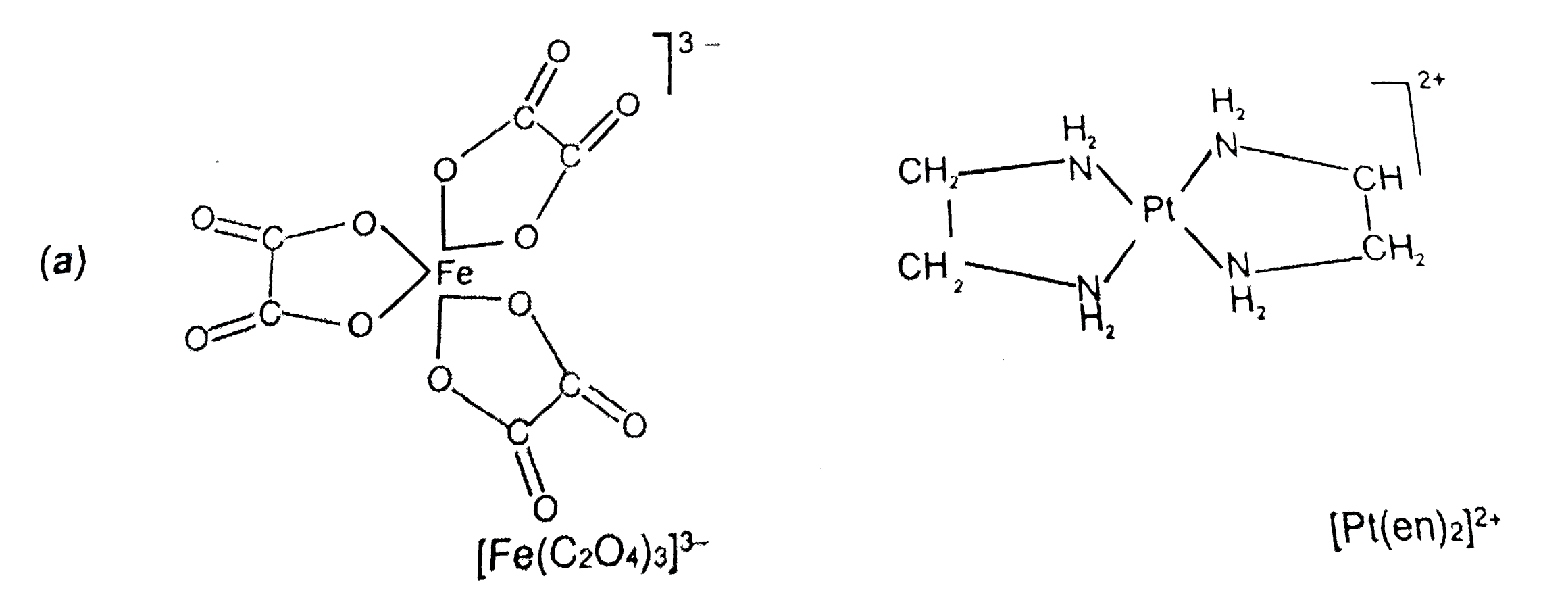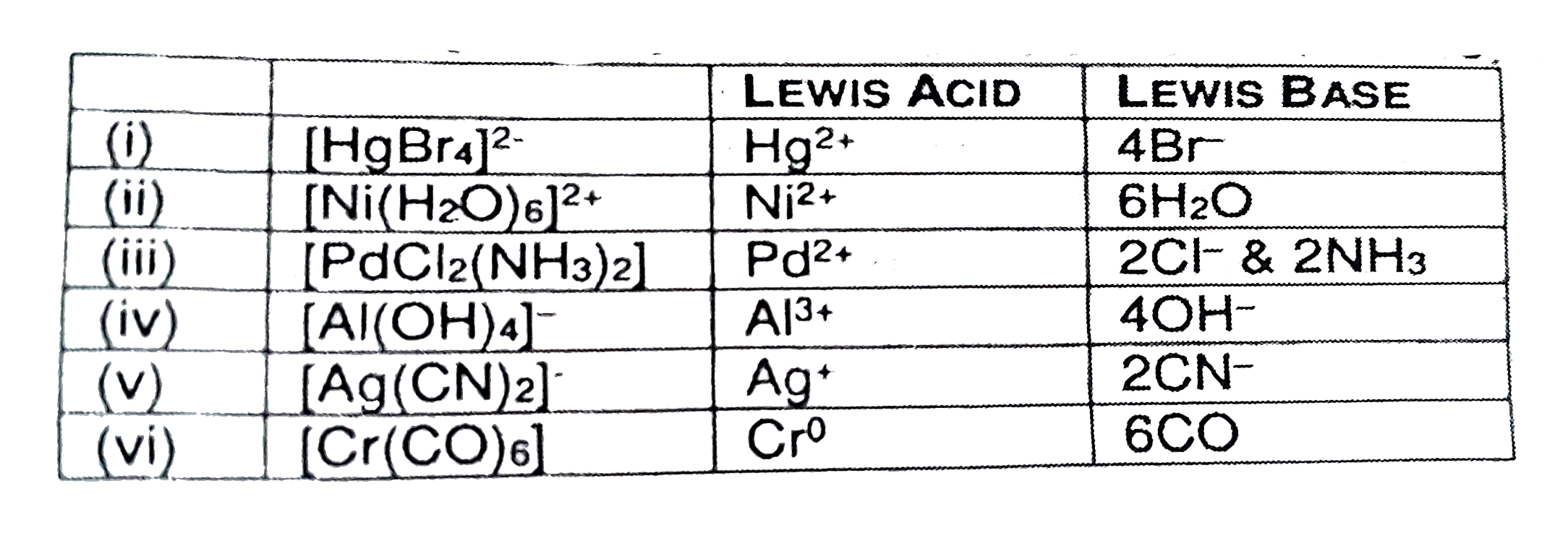(a) Determine the denticity of the ligands in complexes [Fe(C2O4)3]3−and[Pt(en)2]2+. What are the coordination number and the oxidation number of the central metal ion ?
(b) Designate the coordination entities and counter ions in the coordination compounds.
K2[Ni(CN)4],[Cr(en)3]Cl3,F4[Fe(CN)6]3,[PtCl2(en)2](NO3)2.
( c) Identify the Lewis acid and Lewis base components of the following complexes.
(i)[HgBr4]2− (i)[Ni(H2O)6]2+ (iii)[PdCl2(NH3)2]
(iv)[Al(OH)4]− (v)[Ag(CN)2]− (vi)[Cr(CO)6]
Text Solution

The ligands, oxalate and ethylenediamine are bidentate as ech ligand has two donor atoms. So in 1st case the number of chelate rings (five membered ) are three where as in 2nd case the number of chelate rings (five membered ) are two.
The coordination number and oxidation stae of iron are six and +3 respectively and the coordination number and oxidation state of platinum are four +2 respectively.
( b)K2[Ni(CN)4]aq⇐⇒2K+(aq)+[Ni(CN)4]2−(aq)
[Cr(en)3]Cl3aq⇐⇒[Cr(en)3]3+(aq)+3Cl−(aq)
Fe4[Fe(CN)6]3aq⇐⇒4Fe3+(aq)+3[Fe(CN)6]4−(aq)
[PtCl2(en)2](NO3)2aq⇐⇒[PtCl2(en)2]2+(aq)+2(NO3)−(aq)
So, [Ni(CN)4]2−,[Cr(en)3]3+,3[Fe(CN)6]4−and[PtCl2(en)2]2+ are coordination entities and K+,Cl−,Fe3+andNO−3 are counter ions.
( c) Coordination compounds are acid-base adduct. Cations are electron deficient, therefore, are called Lewis acids where as ligands are electrons donor, therefore, are called as Lewis base.

|
Updated on:21/07/2023
Topper's Solved these Questions
- BOOK - RESONANCE ENGLISHCHAPTER - COORDINATION COMPOUNDSEXERCISE - Exercise Part-I: Subjective Question Section (B)4videos
COORDINATION COMPOUNDS
- BOOK - RESONANCE ENGLISHCHAPTER - COORDINATION COMPOUNDSEXERCISE - Exercise Part-I: Subjective Question Section (C)4videos
COORDINATION COMPOUNDS
- BOOK - RESONANCE ENGLISHCHAPTER - COORDINATION COMPOUNDSEXERCISE - Miscellneous Solved Problem (MSPS)20videos
COORDINATION COMPOUNDS
- BOOK - RESONANCE ENGLISHCHAPTER - CHEMISTRY IN EVERYDAY LIFEEXERCISE - ORGANIC CHEMISTRY(Chemistry in every day life)31videos
CHEMISTRY IN EVERYDAY LIFE
- BOOK - RESONANCE ENGLISHCHAPTER - D & F BLOCK ELEMENTSEXERCISE - ORGANIC CHEMISTRY(Aldehydes , Ketones, Carboxylic acid)15videos
D & F BLOCK ELEMENTS
Similar Questions
Knowledge Check
- Question 1 - Select One
The coordination number and oxidation number of the central metal ion in the complex [Pt(en)2]+2 is-
AC.N. = 2, O.N. = +2BC.N. = 6, O.N. = +4CC.N. = 4, O.N. = +4DC.N. = 4, O.N. = +2 - Question 2 - Select One
In the complexes [Fe(CN)6]3−and[Pt(en)(H2O)2(NO2)(Cl)]2+ the respective oxidation numbers of central metal atoms are :
A+3and+4B+6and+4C+6and+3D+3and+3 - Question 3 - Select One
The sum of coordination number and oxidation number of the metal M in the complex [M(en)2(C2O4)]Cl (where en is ethylenediamine) is:
A9B6C7D8
Write the IUPAC names of the following coordination compounds :
(i) [Cr(NH3)3Cl3]
(ii) K3[Fe(CN)6]
(iii) [CoBr2(en)2]+, (en = ethylenediamine)View SolutionSpecify the oxidation numbers of the metals in the following coordination entities :
[Co(H2O)(CN)(en)2]2+View SolutionWhat is the coordination number of central metal ion in [Fe(C2O4)3]3− ?
View SolutionWhat is the coordination number of central metal ion in [Fe(C2O4)3]3−
View SolutionThe sum of coordination number and oxidation number of the metal M in the complex [M(en)2(C2O4)]Cl (where en is ethylenediamine) is:
View Solution

